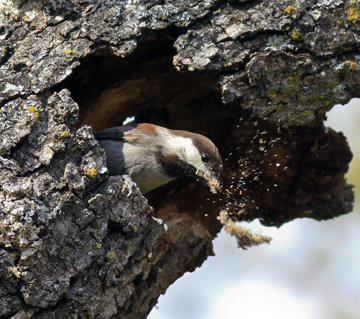 Photo ©
Hawk Person
Photo ©
Hawk Person
Creating starter holes for cavity-nesting birds
If you have put up a nest box, you may have noticed that during the breeding season it becomes prime real estate. As you may know, nest boxes are substitute cavities (a cavity being any hole in a tree), often placed in areas where there are no longer standing dead trees which provide natural cavities. But did you know that you can create starter holes which will eventually become cavities? There are several advantages to cavities over nest boxes: they require less maintenance, are inconspicuous to the public, and appeal to a wider variety of birds.
To start a natural cavity, find a tree whose heartwood is rotten but which still has intact bark; strong bark keeps predators from enlarging the entrance hole. Drill a 2″-diameter hole into the heartwood about 3″ below a stout limb. This is a great entry point for a chickadee to begin excavating the rotten wood! If you can do this on a downward-facing side of a tree, that will help to keep the rain out. You can also start a cavity by cutting a limb of at least 3″ in diameter from the tree, leaving about 6″ of limb on the trunk (this is called the branch collar). The cut limb will rot and the tree will heal around the hole. In cold-climate regions, consider orienting cavities to the south or east to maximize their sun exposure. In warmer climates, cavities may be oriented north or west to reduce overheating. Keep in mind that cavities should be started in appropriately-sized trees and of sufficient height to attract your target species. Don’t have a target species? Start your cavity in the 6-10′ height range, and then just let it rot.
 Photo ©
Photo ©